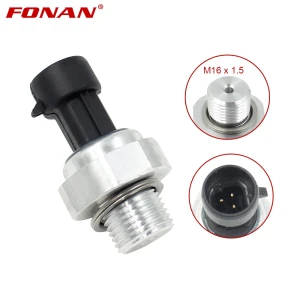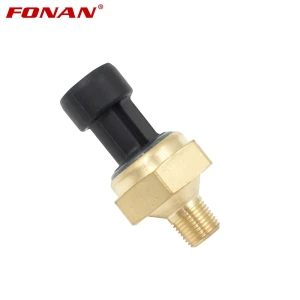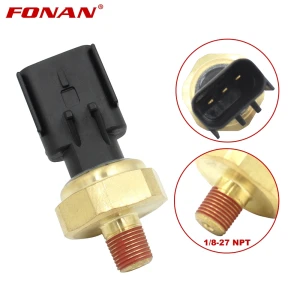Date: 2024.11.02 Click: 674
1. Definition and Function of Automotive Oil Pressure Sensor
An automotive oil pressure sensor is a device used to measure the pressure of engine oil or hydraulic oil. It can monitor the pressure changes of the liquid in real time and convert it into an electrical signal, which is transmitted to the vehicle's electronic control unit (ECU) or dashboard. This sensor plays a vital role in the vehicle, and its main functions include:

Real-time monitoring: The oil pressure sensor can provide accurate oil pressure readings to help the driver understand the operating status of the engine.
Protect the engine: By monitoring the oil pressure, the sensor can detect potential oil pressure problems in time, thereby preventing engine wear and failure caused by insufficient lubrication.
Improve performance: Ensuring that the engine oil pressure is within the normal range helps optimize engine performance and fuel economy.
2. Working principle of oil pressure sensor
The working principle of oil pressure sensor mainly relies on pressure measurement and signal conversion. Its basic process is as follows:
Pressure sensing: When the engine is running, the oil pump presses oil into the engine. The diaphragm inside the oil pressure sensor will be deformed by the oil pressure.
Signal conversion: The deformation of the diaphragm is converted into an electrical signal through different technical means (such as resistance, capacitance or voltage change). The strength of this signal is proportional to the oil pressure.
Signal transmission: The converted signal is sent to the ECU or directly displayed on the dashboard, allowing the driver to monitor the oil pressure in real time.
Through these steps, the oil pressure sensor can provide accurate oil pressure data to ensure that the engine operates within a safe range.

3. Main types of oil pressure sensors
There are many types of oil pressure sensors, each with different working principles and application scenarios:
Piezoelectric sensor: Utilizes the characteristics of piezoelectric materials to generate voltage changes. This sensor is sensitive to dynamic pressure changes and is suitable for high-performance vehicles and complex working conditions.
Resistive sensor: Uses strain gauge technology to measure the resistance change after the diaphragm is subjected to force. This type of sensor is widely used in various automobiles and mechanical equipment with high accuracy and stability.
Capacitive sensor: Determines the oil pressure by measuring the capacitance change caused by the pressure change of the diaphragm. This sensor performs well in high temperature and high humidity environments and is suitable for hydraulic systems and high-demand applications.
4. Application scenarios of automotive oil pressure sensors
Automobile oil pressure sensors play an important role in a variety of scenarios:
Engine oil pressure monitoring: Oil pressure sensors can monitor the oil pressure of the engine in real time to ensure the normal operation of the lubrication system and prevent engine damage caused by low oil pressure.
Pressure monitoring of hydraulic systems: In industrial equipment and hydraulic systems, oil pressure sensors are used to monitor the pressure of hydraulic oil to ensure the safe operation of equipment and prevent failures caused by overpressure or low pressure.
Alarm and safety protection function: When the oil pressure is lower than the set value, the oil pressure sensor can sound an alarm to prompt the driver or operator to take timely measures to prevent potential mechanical failures.

5. Common faults and maintenance suggestions
Although oil pressure sensors are generally reliable, some faults may still occur during use:
Common fault phenomena: The oil pressure indicator light is on, the dashboard display is abnormal, the engine makes abnormal noise or runs unsteadily, etc., which may indicate that the oil pressure sensor is faulty or the oil pressure is insufficient.
Maintenance and inspection methods: Regularly check the oil pressure sensor and its connecting wires to ensure that there is no wear or corrosion. When maintaining the engine, check the oil status to ensure that it is clean and within the normal range.
Regular maintenance and timely inspections can extend the service life of the oil pressure sensor and ensure the normal operation of the engine.

Conclusion
The automotive oil pressure sensor is a key component to ensure engine safety and performance. It protects the engine from damage and improves overall performance by monitoring oil pressure in real time. Understanding the working principle, types and applications of oil pressure sensors is essential to maintaining the health of the vehicle.
Content reference sources
Automotive engineering related books and technical literature
Industry reports on sensor technology and automotive electronic control
Official technical information from automobile manufacturers
Please leave your requirements and contact information, and we will send you the quotation information as soon as possible.